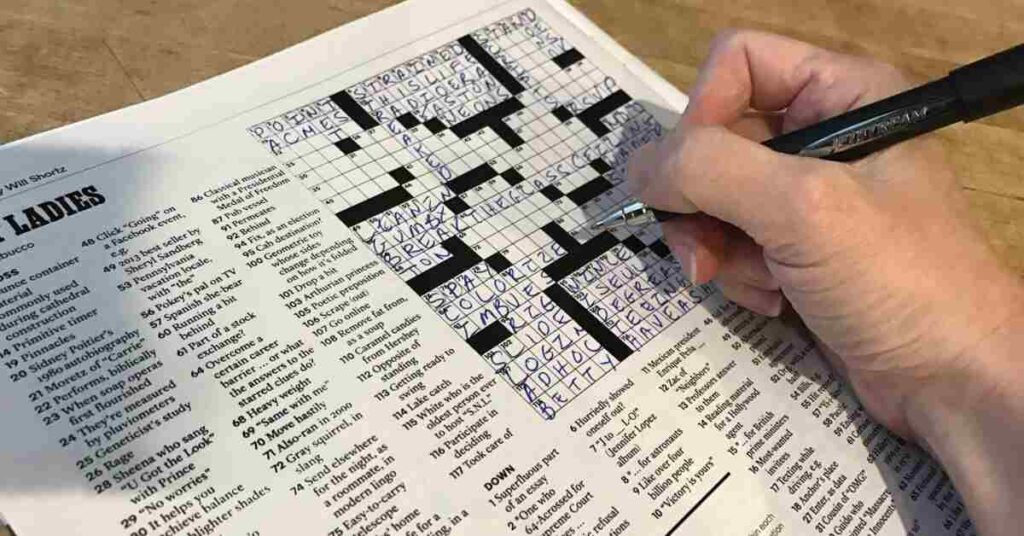Solving the Crested Woodland Bird NYT Crossword Puzzle involves more than just filling in squares. A crossword is a word puzzle where you fit words into a grid based on clues. Each clue leads you to fill in a word that fits both the space and intersecting words. Understanding how to approach these clues is key to solving the puzzle.
Imagine a puzzle where each clue is a bird call, guiding you to the right answer. The Crested Woodland Bird NYT Crossword Puzzle offers a unique challenge, blending your love for birds with clever wordplay. As you solve, you’ll find new terms and test your knowledge in an engaging way.
Crosswords have been a popular pastime for decades. They consist of a grid where words are placed according to clues. These clues can be straightforward or tricky, testing your vocabulary and knowledge. With each puzzle, you get to exercise your brain and enjoy the satisfaction of finding the right answers.
Introduction to the Crested Woodland Bird Crossword Puzzle
The Crested Woodland Bird NYT Crossword Puzzle is a beloved brain teaser that’ll have you singing a happy tune. This isn’t just any old word game – it’s a chance to spread your wings and soar through a forest of clever clues and tricky wordplay. Imagine you’re on a thrilling hunt through the woods, searching for elusive feathered friends.
That’s the kind of excitement the Crested Woodland Bird puzzle brings to the table. It’s been a staple of The Gray Lady for years, challenging puzzle lovers to test their wits against some of the craftiest clue-makers in the business. Whether you’re a seasoned solver or a fledgling enthusiast, this puzzle offers a unique blend of ornithological knowledge and linguistic acrobatics that’ll keep you coming back for more.
UNDERSTANDING THE CLUES AND FILL-IN-THE-BLANK FORMAT
When it comes to decoding clues in this avian adventure, you’ll need to think like a bird watcher with a dictionary in hand. The NYT crossword is famous for its clever wordplay, and the Crested Woodland Bird edition is no exception. You’ll encounter a mix of straightforward definitions, crafty puns, and sneaky misdirections that’ll test your ability to interpret hints.
Fill-in-the-blank clues are often the low-hanging fruit in this puzzle. They’re like spotting a bright red cardinal in a sea of green – they stand out and give you a solid starting point. But don’t let your guard down! Even these can have a twist, perhaps referencing an obscure avian species or a lesser-known forest dweller. The key is to read each clue carefully, considering both its literal meaning and any potential wordplay.
Tips for Solving Commonly Used Words And Phrases In Crossword Puzzles
- Familiarize Yourself with Common Abbreviations: Learn standard abbreviations frequently used in crosswords, such as “Ave” for Avenue or “Dr” for Doctor. These can help you quickly solve clues.
- Know Frequent Crossword Terms: Recognize words and phrases that often appear in puzzles, like “Oreo” for a well-known cookie or “Eagle” for a bird. These recurring terms will make solving easier.
- Master Synonyms and Variations: Expand your vocabulary to include synonyms and variations of common words, like “Glimpse” for “Peek” or “End” for “Finish.” This will help you navigate tricky clues.
- Learn About Crosswordese: Get acquainted with crossword-specific lingo, such as “Oleo” for margarine or “Etc.” for “and so on.” Knowing these can give you an edge in solving.
- Study Bird-Related Terms: For puzzles with themes like birds, familiarize yourself with avian terms and classifications, such as “Eagle,” “Finch,” or “Aerie” (a bird’s nest).
- Practice with Puzzle-Specific Vocabulary: Use crossword puzzle dictionaries or apps to identify and learn the terms that frequently appear in different types of puzzles.
Researching and Gathering Information

Start by compiling knowledge about various woodland bird species, their habitats, behaviors, and distinctive features. Field guides, nature documentaries, and reputable birding websites can be goldmines of information. Don’t limit yourself to just facts about birds, though. The puzzle often incorporates broader themes related to forests, conservation, and ecology.
Assembling intel on these topics will help you tackle clues that go beyond simple bird identification. Create a study routine – maybe learn about a new bird species each day. Before you know it, you’ll have built up an impressive reservoir of avian trivia that’ll serve you well when faced with even the trickiest clues.
Starting with the Known Answers
When you first unfold that crisp newspaper or open the digital puzzle, don’t dive in beak-first. Take a moment to scan the clues and identify your sure bets. These known answers are like the first few notes of a bird’s song . they set the rhythm for the rest of your solving experience.
Start by filling blanks with the answers you’re absolutely certain about. This might include common crossword staples, straightforward definitions, or topics you’re particularly knowledgeable about. As you pencil (or type) these in, you’ll start to see patterns emerge. Intersecting letters from your known answers will provide valuable hints for crossing words, helping you to gradually unravel the mystery of the puzzle grid.
Tackling the More Difficult Clues
Now comes the real challenge – those clues that seem as elusive as a rare winged inhabitant of the deep forest. When faced with a particularly perplexing clue, break it down into parts. Look for indicators of wordplay, such as “sounds like” for homophones or “hidden in” for answers embedded within the clue itself.
Don’t be afraid to think outside the nest. The Crested Woodland Bird puzzle often employs clever misdirection. A clue that seems to be about a bird might actually be referencing a completely different use of the word. For instance, “Flyer in the woods?” could be hinting at a leaflet rather than a bird. If you’re truly stumped, it’s okay to leave it blank and move on. Sometimes, solving strategies involve coming back to difficult clues after you’ve filled in more of the puzzle.
Checking and Rechecking Answers
Verifying solutions is as crucial as identifying birds correctly in the field. Once you’ve filled in a significant portion of the puzzle, take a step back and review your work. Check that each answer makes sense both for its own clue and in the context of intersecting words.
Pay special attention to unusual spellings of bird names or scientific terms. It’s easy to slip up on the spelling of “ptarmigan” or “pheasant” if you’re rushing. Use crossword solving apps or online tools for answer validation if you’re unsure. Remember, accuracy confirmation isn’t just about being right – it’s about learning and improving your skills for future puzzles.
Tips for Avoiding Common Mistakes
- Assuming All Answers Are Bird-Related: Remember, the Crested Woodland Bird crossword may include general knowledge clues beyond the bird theme.
- Overconfidence in Bird Knowledge: Even if you’re familiar with many bird species, don’t skip careful reading of clues. Consider all possible meanings and wordplay.
- Confusing Similar-Sounding Names: Watch out for mix-ups between similar-sounding bird names, like “grebe” and “grouse,” which can disrupt your solving flow.
- Neglecting Clue Interpretation: Always interpret clues in both their literal and figurative senses to avoid misidentification.
- Rushing Through Answers: Take your time to double-check answers and ensure precision. Quick guesses can lead to errors.
- Ignoring Wordplay: Be mindful of wordplay and puns in clues. They can often lead to answers that aren’t immediately obvious.
USING WORD ASSOCIATION AND SYNONYMS TO SOLVE TRICKY CLUES

Developing strong semantic connections is like creating a mental map of the forest canopy. When you encounter a tricky clue, start by listing out words associated with the given hint. For a clue about a woodpecker, you might think of “drumming,” “tree trunk,” or “red crest.” This brainstorming can often lead you to the correct answer or at least point you in the right direction.
Synonyms are another powerful tool in your crossword toolkit. Clue writers love to use less common words to describe familiar concepts. For example, instead of “beak,” a clue might use “bill” or even “neb.” Expanding your vocabulary of bird-related terms will significantly boost your solving speed. Consider creating your own thesaurus of avian terminology, grouping words by categories like body parts, behaviors, or habitats.
Resources for Additional Help
When you’re feeling as lost as a migratory bird in a storm, it’s time to call in some backup. Fortunately, there’s a whole flock of supplementary aids available for crossword enthusiasts. Websites like XWordInfo and Crossword Tracker can be invaluable for looking up specific clues or patterns of letters.
For bird-specific help, the Cornell Lab of Ornithology’s website is a treasure trove of information. They offer detailed species profiles, sound recordings, and even live bird cams that can deepen your understanding of our feathered friends. Don’t forget about good old-fashioned books either. A comprehensive bird guide or a crossword puzzle dictionary can be your best friend when digital resources aren’t at hand.
Using Crossword Puzzle Thesauruses and Online Resources
Crossword lexicons have evolved from dusty tomes to sophisticated online tools. Websites like OneLook Reverse Dictionary allow you to enter a description and get a list of words that fit – perfect for when you know what the answer means but can’t quite grasp the specific term the puzzle is looking for.
For the Crested Woodland Bird enthusiast, there are even specialized birding apps that can complement your crossword solving. Apps like Merlin Bird ID or eBird can help you quickly look up bird species, their characteristics, and ranges. While using these tools, remember that the goal is to enhance your knowledge, not to simply find quick answers. The more you learn and internalize, the more enjoyable and rewarding your puzzle-solving experience will become.
Solving the Puzzle: Step by Step Guide
Approaching the Crested Woodland Bird NYT Crossword with a systematic approach can turn a daunting task into a manageable and enjoyable challenge. Start by giving the puzzle a once-over, noting any fill-in-the-blank clues or answers you’re certain about. Fill these in to create a foundation for the rest of your solving journey.
Next, focus on short words and common crossword answers. These often-repeated terms are like the common sparrows of the puzzle world . They might not be the most exciting, but they’re crucial for filling out the ecosystem of your grid. As you progress, alternate between easier and more challenging sections of the puzzle. This methodical process keeps the solving experience fresh and prevents frustration from setting in when you hit a particularly tricky patch.
Conclusion
Mastering the Crested Woodland Bird NYT Crossword Puzzle is a journey of patience and practice. Like becoming an expert birder, it involves learning from mistakes and gradually honing your skills. Each puzzle enriches your knowledge and enhances your expertise in both wordplay and ornithology.
The joy of solving comes not just from filling in the grid but from discovering fascinating facts about woodland birds and expanding your vocabulary. Whether you use a pencil or an app, settle in, and embrace the challenge. Your crossword skills will soar as high as the crested birds you’re learning about.

